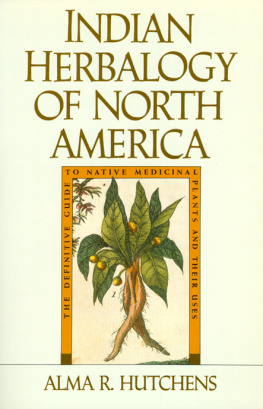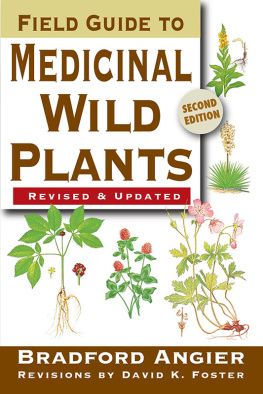
Burdock root can be used as a metabolic tonic and a nourishing food.
MIDWEST
MEDICINAL
PLANTS
IDENTIFY, HARVEST, AND USE
 109 WILD HERBS
109 WILD HERBS
FOR HEALTH AND WELLNESS
LISA M. ROSE

To the glaciers
Thank you for creating the Great Lakes,
a special place I call home.
CONTENTS
 PREFACE
PREFACE
GROWING AN HERBALIST
If the earth needs an herbalist, it will grow one.
jim mcdonald, Great Lakes herbalist, 2010
I first turned to the plants for guidance at the age of 30. Although Id always been a plant person, Id been working against natures cycles and against my own. I was worn out, tired from the cultural stress that I was carrying from running an NGO , being a mom to two small kids, and being a good wife.
A gardener, I was even too tired to plant seeds in the springtime or clear away the winters debris. Maybe you shouldnt clear away the debris or plant anything this year, a wise farmer friend told me. Maybe you should just listen to the plants and see what they have to say.
This was the beginning of my practice as an herbalist. I sat down and began to listen to the plants. I let my garden go fallow and watched the land take over in the way that it knows how to do.
My interests in gardening slowly transformed into working nearly entirely with wild plants. I noticed the weeds growing between the cultivated plants and between the cracks in the sidewalk. I wondered about their resilience and their potential healing powers. I learned their names and how they tasted, smelled, and felt in my fingers.
Burdock called to me from the ditches of my friends farm. Burdock would become the first plant Id work with as an herbal medicine. And my apothecary grew, as did a need for my teachings in my community.
I was called to be a teacher in 2010 by my own teacher, Jim McDonald. Lisa Rose, if it looks like a duck and quacks like a duck, its a duck, said Jim. You work with wild plants. You make plant medicines. You share them with others. You, in fact, are an herbalist.

Wildcrafting elderflowers.
From that point forward, I opened my gardens and apothecary to my community. Jim and others sent clients my way for my practice. I was scared that I didnt know enough. But instead of being stuck in that rut, I stepped forward to teach what I knew. Since that time, Ive never really looked back. And with an insatiable curiosity, Ive never stopped being a student of the plants.
You will find that this book is filled with nuggets of learning that Ive acquired across a delicious and healing journey with the plants. Its what I know. Ten years from now, I hope to know more, layered upon this foundation.
In your herbal journey, I encourage you to start with what you know. Go outside and listen to the plants. Touch, taste, smell, and repeat. Get to know the plants on an intimate level. And share this love with everyone you know.
You are an herbalist, and the earth needs you.

Start with what you know. Go outside and listen to the plants. Touch, taste, smell, and repeat. Get to know the plants on an intimate level.
WILDCRAFTING BASICS
Imagine this at the end of your harvest season: your own herbal apothecary, filled with local plants and herbs that you can turn to as you feel a cold coming on or notice a stomach upset after an indulgent meal. There is nothing more gratifying than to know that you can keep yourself and your family healthy throughout the year with the plant-based medicines youve created from the wild plants youve gathered, or wildcrafted, from the fields, hedgerows, and woodlands around you.
For many, an herbal apothecary evokes images of shelves full of bottles and jars filled with mysterious herbs and herbal formulas from exotic plants. But to create an herbal apothecary that your family can turn to for basic ills and chills, you dont need to include exotic or mysterious plants. In fact, as you realize that you can incorporate local plants and herbs into your natural wellness routines, you can begin to create a personal apothecary using plants that grow just outside your front stoop.
All you need to do is pay attention to the plants growing around you. This will help you connect to the land and nature itselfeven as youre engulfed by our manic, developed world. Eating wild foods and using plant medicines created from the fruits of the earth will bind you to a placeits rivers, animals, smells, sights, and sounds. Ingesting these fruits makes a place literally a part of you, so that the land and its story become your storya story of the earth, people, politics, and infrastructure all bound together by an invisible red thread. It is healing, this wild medicine.

Monarda fistulosa, wild bergamot, is often incorporated into landscape designs and is a useful medicine.
As herbalists, we are land stewards. Working with wild plants requires that we understand not just their botany, but their abundance and impact in our bioregion. We should know whether a plant is endangered (and should not be wildcrafted) or invasive (which can be the best to wildcraft from a sustainability standpoint). We should know how to wildcraft a plant in the most careful way so that it can continue to reproduce for future harvests and enjoyment.
Know and pay attention to the bounty (or lack thereof) thats around you. This information should guide you first and foremost in your wildcrafting. Get to know the various habitats that surround you. Plant populations vary in each habitat, from hardwood deciduous forests, to wetlands, to urban lots. Over time, you will know intimately the microclimates and plant life in your area, including which plants might be threatened or limited in amount.
HOW TO USE THIS BOOK ON YOUR JOURNEY
Use this book to hone your skills as both a wildcrafter and medicine-maker. Both new and experienced herbalists will find this guide to be a useful addition to their medicine-making toolkits. Those who are simply interested in greening up their kitchens and medicine kits will also find plenty of information about exploring a hyperlocal source for plant-based remedies for everyday wellness needs.
Within each plant profile in the book, I discuss how to harvest the plants safely to avoid negatively impacting the plant population. Remember to do no harm, and leave the places in which you harvest better than when you found them.
Next page












 109 WILD HERBS
109 WILD HERBS



